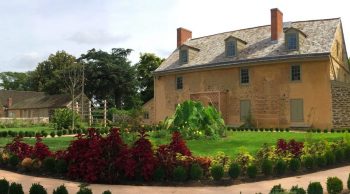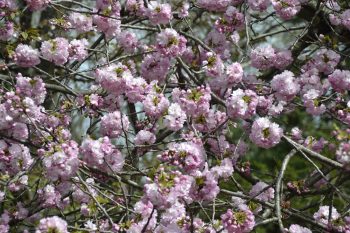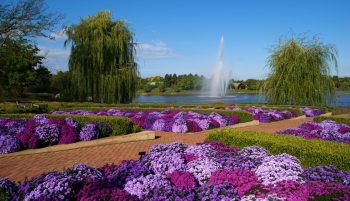By Denny Dyroff, Entertainment Editor, The Times
“April Showers” are done and now it’s time for “May Flowers.”
Garden sites and horticultural attractions all over the Northern Hemisphere usually are a bustle of activity with visitors arriving to check out this year’s spring flowers in an attractive live setting.
But COVID-19 has forced everyone to stay at home in order to “shelter in place.” Since you can’t go to the gardens, the gardens are coming to you. You can visit them in the comfort of your living room, office or den – virtually via the internet.
While you won’t be able to enjoy the sweet fragrances of blooming flowers, you will be able to take in their beauty visually.
On its website, Longwood Gardens (https://longwoodgardens.org/) in Kennett Square has posted this message –
“We miss you. We miss our Gardens. So, we thought we’d bring part of our Gardens right to you. “Our Gardens Your Home” is designed to keep you connected to your favorite garden (and ours) in a different way through stunning imagery and video of what’s in bloom, engaging online classes and activities for all ages, our legacy, and special moments expressing our mission of horticulture, education, and the arts. Our desire to create beauty and offer you a world apart has never been more important. Stay connected with us and make our Gardens your home.”
“‘Our Gardens Your Home” has three parts – “Look and Breathe,” “Listen and Explore” and “Learn and Discover.” Here is how Longwood gardens’ website describes this online project.
In “Look and Breathe,” you can enjoy video and image highlights of the colorful emergence of spring by following Longwood on Instagram, Facebook, and Twitter.
Some of the offerings in “Look and Breathe” are:
“Saving Our Global Garden” — Everybody needs beauty, especially now. Join our President and CEO Paul B. Redman as he explores our global garden and explains why, once we learn to see the beauty that surrounds us, we’ll better understand what’s worth saving.
“Tulips on Display” — It’s tulip time! Join Garden Manager Roger Davis on a tour of our blooms.
Video link for Longwood’s Tulip Display — https://youtu.be/rGutZt0DMZc.
“Brighten Your Day With Floral Design” — Nothing brightens your day like a beautiful floral arrangement. We introduce you to the talented team that brings our floral design classes to life … and to your home.
“Spring Blooms” — Magnolia Tree in Bloom, Spring Blooming on Oak & Conifer Knoll, Flowering Cherry Trees, Tulips On Display, Spring’s Hidden Gems, Flowering Trees during Spring at Longwood Gardens.
Video link for “Spring Blooms” — https://youtu.be/eunn93zeSm8.
“Gardens Spotlight” — We’ve dug into our photo and video archives to share some of the inspiration and beauty from some favorite past displays. Enjoy spring splendor from 2018.
Some of the offerings in “Listen and Explore” are:
“Enjoy an Exclusive Performance” — Follow along as our Principal Organist Peter Richard Conte showcases the intricacies of the magnificent Longwood Organ, as well as plays Aria by Longwood’s first principal organist, Firmin Swinnen.
“Explore the Chimes Tower and its Carillon” – Unveil the enigma of our Chimes Tower and the sounds of its 62-bell, five-octave carillon … and watch as carillonneur Roel Smit expertly plays its 6-foot-wide keyboard.
“Find Out About Floral Design and Other Plant-Related Careers” — Learn more about careers in horticulture through the Seed Your Future initiative.
“Meet the Longwood Organ” — Learn about and hear our 10,010 pipe organ, one of the largest residential organs in the world.
“Hear from a Gardener” — The Garden Hoes Podcast chats with our very own orchid grower, Greg Griffis.
“Garden Tour” — Check out UK gardening guru Monty Don at Longwood as part of his new series Monty Don’s American Gardens. The Longwood portion begins at 11:15 in the episode.
Some of the offerings in “Listen and Explore” are:
“Create a Bonsai” — Our own bonsai expert Kevin Bielicki demonstrates how to create a bonsai from nursery stock.
“Kokedama at Home” — Kokedama (Japanese for “moss ball”) is a decorative style of potting plants in a ball of moss and displaying them in a dish or suspended in the air. Make your own kokedama with this easy step-by-step guide.
“Celebrate Trees” — Learn some fun facts about trees, planting and caring for them, and meet some of our smallest trees in this virtual field trip.
“Flower Memory Match” — Test your memory and learn some new flower names in this matching game for the whole family.
“Floral Design With Orchids” — Join acclaimed floral designer Cres Motzi as she shares tips and tricks for creating floral arrangements with orchids and other materials.
“Read a Good Plant Book” — Join our Community Read and dive into the wacky, weird, and wild world of plants with one of these books: Semiosis by Sue Burke, Weird Plants by Chris Thorogood, and The Enormous Potato by Aubrey Davis.
“Go On a Virtual Field Trip” — Discover the fascinating world of carnivorous plants in this online field trip.
Winterthur’s Response to COVID-19 according to its website –
Winterthur Museum, Garden & Library (http://www.winterthur.org/ ) is temporarily closed to the public.
Under Delaware Governor John Carney’s state-of-emergency declaration, Winterthur is closed until further notice. The safety and wellbeing of the community remains our highest priority, and we are committed to supporting the nationwide effort to contain the spread of COVID-19.
We are committed to bringing Winterthur to you in new and compelling ways through virtual experiences of our museum, garden, and library. We invite you to explore with us at @winterthurmuse on Instagram, Facebook, and Twitter.
Follow this link for a virtual tour of Winterthur — http://www.winterthur.org/visit/tours/virtual-tour/
Delaware’s Mt. Cuba Center (https://mtcubacenter.org/visit/tour/spring/) has virtual tours of acres gardens filled with native plants. You can even switch between seasons to see how the gardens change.
This was posted on the garden attraction’s website —
The health and well-being of Mt. Cuba Center staff, members, guests, and community is always of paramount importance.
In light of Delaware Governor John Carney’s stay-at-home order, Mt. Cuba Center is canceling garden visitation, classes, and events until the order is lifted and the threat to public health has sufficiently abated. An opening date for the gardens will be announced once we determine when we are able to safely welcome guests.
In lieu of visiting the gardens in person, we welcome you to visit us virtually in our series of online garden tours in spring, summer, and fall. You can find these tours on our website at mtcubacenter.org/visit/tour/spring. You can also follow us on Facebook, Instagram, and YouTube for regular updates and beautiful garden photos and video.
We continue to monitor the COVID-19 news and guidelines and will prioritize the safety of our staff, members, guests, volunteers, and community above all else.
Philadelphia’s Bartram’s Garden (https://bartramsgarden.org/) is offering an interactive garden tour complete with a map.
This interactive map and its highlighted attractions offer starting points for unfettered exploration at Bartram’s Garden.
Some of the featured attractions are Bartram House, Coach House, Historic Garden, Bartram Barn, Medicinal Plant Display, The Ann Franklin Bartram Garden, Franklinia Tree and Ginko Tree.
Billed as “America’s oldest living botanical garden,” this oasis on the Schuylkill was started in the 18th century by Quaker farmer and self-taught botanist John Bartram, who was determined to collect as many different North American plants as he could. He traded cuttings, seeds and info with fellow farmers Thomas Jefferson and George Washington, and eventually was named Royal Botanist to King George III.
Today his former estate is a 45-acre National Historic Landmark featuring native and medicinal plants, meadows, ancient trees, and breathtaking views of the city skyline
The Brooklyn Botanic Garden (https://www.bbg.org/collections/cherries) is keeping watch on cherry blossoms, and you can follow along as the petal pink flowers go from pre-bloom, first bloom, peak bloom and post-peak bloom. You can also virtually stroll the Japanese Hill-and-Pond Garden and the Cherry Esplanade and Cherry Walk, for additional cherry blossom content.
Keukenhof (https://keukenhof.nl/en/nieuws/360-tour-door-keukenhof/) in the Netherlands is providing people a glimpse of famous Holland tulips with a 360-degree guided tour of the gardens. Dating back to the 15th century, Keukenhof has become synonymous with spring bulbs, and the annual event brings in hundreds of thousands of visitors every year.
Keukenhof, which in Dutch means ‘kitchen garden’, has been around for more than five centuries and covers 32 hectares. It became a public garden in 1950 and now welcomes more than a million visitors a year. Highlights are an authentic 19th-century windmill and a gigantic flower bulb mosaic featuring 50,000 tulips, grape hyacinths and crocuses.
One of Canada’s premier botanical landmarks, Buchart Gardens in British Columbia (https://www.butchartgardens.com/a-virtual-visit/) was actually a limestone quarry a century ago. The empty pit has since been completely transformed into lavish gardens, complete with a hand-carved carousel. It’s closed now but you can currently experience the site’s virtual garden tour.
Chicago Botanic Garden (https://www.chicagobotanic.org/app/) consists of 385 acres and has a grand total of 27 gardens and four natural areas.
The Chicago Horticultural Society, which was founded in 1890, officially opened the Chicago Botanic Garden in 1972. To this day, the Chicago Horticultural Society operates the historic garden located in the Windy City, while the Forest Preserve District of Cook County is its owner. Some of the 27 gardens include the English Walled Garden, the Japanese Garden, the Plant Science and a renowned Bonsai Collection.
South of the Alps and north of Milan, Giardini Botanici Villa Taranto (www.villataranto.it/en/gardens/) sits on the shore of Lake Maggiore north of Milan where herbaceous eucalyptus and giant Amazon lilies grow alongside Japanese maples. Clicking on their interactive garden map will take you from the terraced gardens to the dahlias.
The Hawaii Tropical Botanical Garden (http://www.htbg.com/) is located on 17 acres in Papaikou. It includes not only its own garden, but a nature preserve as well. With waterfalls, streams, and a boardwalk situated on the Pacific coast, this virtual tour is a visual treat.
In 1977, Dan J. Lutkenhouse purchased the property that later became the garden, which was created by Lutkenhouse himself. Following the public opening of the Hawaii Tropical Botanical Garden in 1984, the Lutkenhouse family left the property to a nonprofit trust in 1995..
This one-of-a-kind garden is a museum of living plants and it is truly beautiful. The Garden’s collection of tropical plants is international in scope with over 2,000 species, representing more than 125 families and 750 genera.
Throughout the tropical rainforest there are bubbling streams, beautiful waterfalls and exciting ocean vistas along the rugged Pacific coast. A palm rainforest with brightly colored hibiscus flowers and views of the Pacific-ocean takes you on a unique tour of the diverse topography of Hawaii, O’ahu, Kauai and Maui.
The Villandry (www.chateauvillandry.fr) is one of the great French chateaux built on the banks of the Loire during the Renaissance, but its gardens, for the history alone, are equally famous. The vast landscape includes water gardens, a hedge maze, two ornamentals gardens, a kitchen garden and so much more.
The virtual tour of the gardens of Villandry offers a different look at Villandry. You can explore the estate in detail and access original documentary resources and multimedia content.
Portland Japanese Garden (https://japanesegarden.org/coronavirus/) offer visitors a look at something different – an American garden with its roots in the Orient.
Portland Japanese Garden has 360-degree tours of a tea garden, a sand and stone garden, a pond garden and more.
When Baron Ferdinand de Rothschild purchased the Waddesdon Estate (https://waddesdon.org.uk/) in 1874, he had large trees transplanted from near-by estates to create an instant garden. His favorites were the horse chestnut trees, many of which were transplanted over 140 years ago and still survive.
In addition to the building and art collection, the grounds and gardens are a breathtaking example of Victorian horticulture, including formal gardens, trees and walks. What was originally designed for Baron Rothschild’s fancy guests can be viewed from your couch—no formal attire required.
Rothschild family home since the late 1800s and a National Trust property, the utterly majestic Waddesdon Manor is a French Renaissance château, built in the 19th century, and filled with royal treasures and an extensive art collection.
The gardens are an exceptional example of late Victorian garden design and were first conceived by Ferdinand de Rothschild and extended by Alice de Rothschild. Lined with beautiful blooms, tall trees and elegant sculptures and fountains, the gardens are looked after by 19 horticulturists plus a team of dedicated volunteers.
Video link for Waddesdon Manor — https://youtu.be/wAzPrJR9_BA.
The Giardino di Boboli (https://www.uffizi.it/en/boboli-garden/architecture-and-landscape-boboli-gardens) is a magnificent attraction that is part of Firenze’s world-famous museum — The Uffizi.
Constructed by the Medici family, it became the model for Italian garden styles with vast green expanses, grottos and fountains. This garden even includes a rare Tuscan example of Rococo architecture. You can explore the fascinating architecture and design as well as the botany and sculpture on the property with the simple click of a link.
The U.K.’s crowning garden jewel, Kew Garden in Richmond, England (https://www.kew.org/) is a UNESCO World Heritage Site boasting 37 acres of woodland, 14,000 trees and over 50,000 living plants.
The Arboretum is a living library of trees and the Marianne North Gallery boasts over 800 paintings of plants and flowers. There are also several beautiful historic follies scattered throughout the gardens, including the Pagoda, built in 1762 for Princess Augusta.
The Royal Botanic Gardens at Kew has 37 acres of woodland, 14,000 trees and 50,000 different plant species. The picturesque Victorian glasshouses and Alpine rock garden are two other noteworthy sights.
Video link for Kew Garden — https://youtu.be/8IV-YANXP8g.
The Gardens of Versailles in Paris (http://en.chateauversailles.fr/discover/estate/gardens) is the most iconic French garden in the world. In 1661 André Le Nôtre was commissioned by Louis XIV to tame the woods and marshes into a masterpiece of bioengineering and a tribute to order and symmetry that took 40-years to complete.
Now, almost 400 years later, you have the opportunity to enjoy virtual tours of this historic garden site in the City of Lights.
US Botanic Gardens (https://www.usbg.gov/take-virtual-tour) was established in 1820 and is one of the oldest botanic gardens in North America. The US Botanic Garden is located in Washington, D.C. and is supervised by the Congress through the Architect of the Capitol, who is responsible for maintaining the grounds of the United States Capitol.
From roses to orchids, the rainforest to the Mid-Atlantic, and rare and endangered plants, you will find a world of horticultural delights in the permanent exhibits and gardens. Any time of year, you’ll see something beautiful in bloom at the US Botanic Garden Conservatory, the National Garden, and Bartholdi Park.
Known as a ‘living plant museum,’ the USA’s historic botanic garden sits serenely next to the roar of the Capitol Building in Washington DC. The urban oasis houses 5,000 orchids as well as a rose garden – the floral emblem of the USA since 1986 – and the only garden honoring the contributions of the nation’s first ladies.
Even though it’s autumn in the land of samba, feijoada, carnival and football, it’s still a great time to (virtually) visit Inhotim Institute and Botanical Gardens in Brumadinho, Brazil (https://artsandculture.google.com/partner/inhotim).
This internationally renowned art collection and garden carved out of the Brazilian savanna was master minded by the eccentric mining magnate Bernado Paz.
Videos, installations, sculptures and paintings spring up in 23 pavilions on a 5,000 acre-estate that would take three days to explore on foot.
You can take a virtual tour through more than 79 acres of flowers at the Missouri Botanical Garden (https://www.missouribotanicalgarden.org/).
Spring provides the perfect backdrop for exploration — and stopping to imagine smelling the blossoming flowers.
A popular year-round destination for more than a century and a half, the botanical garden boasts a collection of more than 4,800 trees and a variety of flowers — from azaleas to magnolias.
The Dallas Arboretum (www.dallasarboretum.org/visitor-information/virtual-visit/) is one of the prime natural attractions in the North Texas Metroplex and now offers a virtual visit to the Garden.
The Arboretum’s website states —
Missing the beauty of the Dallas Arboretum?
Let us bring it to you digitally. Experience our breathtaking gardens as Dave Forehand, VP of gardens, leads you on personal tours, learn more about featured garden plants, download garden images to use at home or take a break with a floral jigsaw puzzle.
Denver Botanic Garden (http://navigate.botanicgardens.org/FindTour.html) offers a variety of virtual expeditions. The gardens cover 24 acres and include plants from all over the world.
The Garden’s website has options for following a staff-created tour, such as Outdoor Blooms and Fruit, the Conservatory Palm Collection, or Drought-Tolerant Plants, or creating your own. Search by common name, scientific name, specific characteristics to bring up a variety of plants, then add them to your personalized tour.
If gardens, flowers, fountains and statues aren’t your thing, you could always consider a trip to the 49th State for a virtual dog sled ride in Alaska.
Explore Fairbanks, a tourism authority in Alaska, offers a 360-degree video on YouTube of dog sledding through a snowy forest (https://youtu.be/lX9Iphr8DrU).
Explore Fairbanks (https://www.explorefairbanks.com/explore-the-area/360/) also offers a variety of other virtual experiences in the region including “Explore the Midnight Sun and Northern Lights,” “Float Down the Chena River” and “Experience the Thrill of Dog Mushing.”
No matter how you decide to spend all your extra “free time,” remember to stay at home as much as possible, wash your hands thoroughly, wear a mask if you must go out, wash your hands thoroughly, maintain social distancing, wash your hands thoroughly, and stay out of Georgia (unless you want to be rear-ended by a texting-while-driving, on-the-way-to-a-nail-salon-appointment licensed teen driver who has never passed a driving test).










